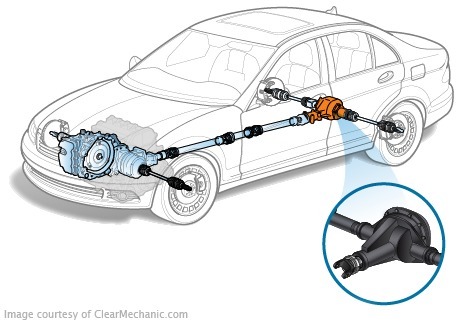
The English acronym LSD (limited slip different) can be translated into Russian as a differential with increased internal resistance. Standard (open, free) differential allows for a difference in the angular velocity of the output, up to the full stop of one of them. This can be seen on a car stuck in the mud when one wheel scrolls and the other is standing still. The LSD differential design includes a lock that allows for a small difference in the speed of the rotation of the gross, but which is activated in the event of a large imbalance between them. In motor vehicles, these locking differentials are used in two main cases: if it is an SUV, or if it is a sports car with an engine that has an excessive torque. In the first case, the lock works so that the car does not get stuck, and in the second case, to ensure effective start from the place, so that the wheels do not slip on the asphalt. How LSD works
How LSD works
Locking, regardless of the design, is triggered when the differences in angular velocity of the wheel exceed a predetermined limit. When the lock is operated, the torque shall be transmitted to both wheels in equal proportions. This shall continue either until contact with the road by both wheels is restored or until the surface is completely lost.
LSD Popular Differential
There are two main types of obstruction of the locks used in the leading car bridges. The first design is based on speed sensitivity. The second design type is a torque-sensitive mechanism. In modern cars, the first type of locks are more popular. The reason is that the first type includes whisk-based locks, that is, simple in production and unassuming maintenance. The second type of mechanical locking is more expensive and is more expensive than before.
LSD Differential Differential Speed Differential
Viscacias
A common type of high friction differential based on the malt. In addition to the reliability of the work, the activity is based on changes in the properties of the special gel, which are changing continuously. Since the main trend in the development of modern cars is the desire to increase the comfort of the driver by any means, this property has proved to be valuable. However, there are also drawbacks to the viscas. As in any node where the effort is made at the cost of liquid pressure, energy is lost, resulting in higher fuel consumption. Second, they are extremely sensitive to overheating-overheating affects the gel, depriving it of its working properties. In other words, encouraging in the snow for a long time, it is possible to be sure that the work of the lock has deteriorated and will be less effective next time. Mechanical locks, for example, work the same until they are broken. In general, the viscone differential requires replacement for a run of 100,000 kilometers.
Like any other fluid reservoir, the templating is sensitive to compaction. Therefore, the interior of the differential makes it completely leakproof so that the silicone gel is not mixed with the transmissive gel oil grease. In case of depressurization, the malt shall be removed and replaced.
Differential based on the herotor pump
In this type of differential, a rotating pump is installed on the inner side, and on the rotating shaft drive shaft, the gear wheel inside the pump is reinforced. If there is a difference in the speed of rotation of the herotor pump and the gear, the liquid shall be compressed inside the pump. The fluid under pressure transmits the torque to the "lagging" wheel, which is currently striving to stop, as it has traction. These systems are rapidly gaining popularity as the computer control of the car's nodes (EBD systems and so on) increases, since unlike the templating, the operation of the herotor pump can be controlled.
LSD Differential Differential of a torque difference
This type is mechanically differential type of a type of worm that provides automatic locking when the difference between the shell and the wheel is actuating the shaft. If one of the wheels is slip, the torque falls, the worm is redistributing the torque to the free wheel. The wheel is not completely blocked and the degree of torque reduction depends on the degree of torque reduction. Self-boating differential (s)
The word Torsen in our time is a trademark, and it was formed with the addition of the two words "torque"-"torque" and "sensing"-"sensitive". Two types of construction are made under the Torsen mark. Quaif-type vehicles
Quaife differential (10) differential (usually 10) is not attached to the axles as analogues, but are located in closed niches of the hull. All of them are parallel semi-axes, but unlike Torsen T2, where each satellite constantly contacts both halves of the six semios, in Quaife, the right series of satellites is in contact with the right half-axes, left-to-left.







